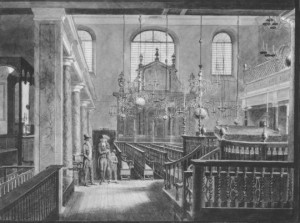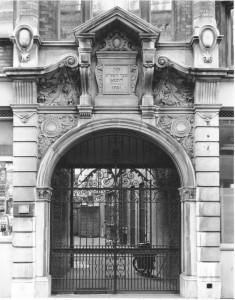History & Design
Situated in the City of London, just off the ancient thoroughfare of Bevis Marks, the synagogue, which was opened in 1701, stands in a secluded courtyard approached through a stone archway with wrought-iron gates. Above the entrance is carved in Hebrew the name of the synagogue, “Kahal Kadosh Shaar Asamaim”, which means “Holy Congregation The Gates of Heaven” and expresses the gratitude for the safe refuge that those first Sephardim felt they had found in the City of London. The courtyard is a place of serenity, now surrounded by office buildings, where once stood the congregation’s school, almshouse and orphanage. The Synagogue is a Grade I listed building and is the only synagogue in Europe that has held regular services continuously for over 300 years.
From these beginnings, the community grew both in numbers and security and, in 1695, plans were made to build a synagogue on a site in Bevis Marks. Four years later, Joseph Avis, a Quaker, was assigned the contract for building at a cost of £2,650, a considerable sum of money at the time. Two tales embedded in the memory of the community are attached to the construction. Firstly, that Queen Anne presented an oak beam from one of the Royal navy’s ships to be incorporated in the roof of the building. The other is that Joseph Avis returned to the congregation the profit that he had made from the project stating that he would not benefit financially from the building of a House of God. Whether true or not, these two stories attest to the fact that the small community of Sephardic Jews owed gratitude to two diametrically opposed groups of friends, the Puritans and the royal House of Stuart.
The architecture of the Bevis Marks Synagogue reflects the Non-conformist chapels built at the same period, particularly the large, rounded leaded-light windows. In the stone portal, above the massive timber doors, is inscribed “A.M. 5461”. This may be translated as “5461 years after the beginning of the world”, the Hebrew year in which the synagogue was constructed. On entering the building through the heavy dark doors, one can see that the original iron locks with massive keys are still in use. Inside, the wooden Ark resembles a reredos or ornamental altar screen. It is classical in style and is thought to have been influenced by the work of Sir Christopher Wren who, at this time, was supervising the rebuilding of the City of London after the Great Fire of 1666. The doors of the Ark are of oak grained to look like mahogany and the interior is lined with Spanish gilded leather. The rows of upright oak seats reflect the Puritanism of 17th century England and the oak backless benches, incorporated among the back rows, are the original seats brought from Creechurch Lane. These were where the children from the synagogal school sat, on the right of the Wardens’ pew, whilst the Orphanage boys sat on the left.
Much of the design and decoration have obviously been influenced by the synagogue in Amsterdam, which had opened twenty-six years earlier. The simple ornament conceals a latent symbolism. The seven hanging many-branched candelabra represent the days of the week. The largest, in the centre, represents the Sabbath and was donated to the Synagogue by members of the Amsterdam Sephardi Congregation. In front of the Ark are six large brass candlesticks and four more stand on the Reading Desk, making ten in total and symbolizing the Ten Commandments. Around the building, supporting the Ladies’ Gallery, are twelve pillars. These symbolically represent the twelve tribes of Israel.
Apart from a few minor additions – doors to the seats of the Haham (Chief Rabbi of the Sephardi Jews), and the assistant rabbis and to the Wardens box (or Banca) in 1787, the special seat for Sir Moses Montefiore, which is fitted with arms and a footrest, the choir stalls in 1830 and electric lighting in 1929, the synagogue remains virtually unchanged. The building survived unscathed during two World Wars. However, in 1992, the building was badly damaged by an IRA bomb, which targeted The Baltic Exchange and caused enormous damage to the surrounding neighbourhood. The Chairman of Buildings for the Spanish & Portuguese Congregation, donning a hard hat and with police escort, was one of the first people to enter the cordoned area of streets to examine the damage to the Synagogue. He, with the agreement of the insurance company, put in place a programme of repair which lasted more than four months but enabled the building to be restored. By the time the work was finished, the synagogue had a totally new ceiling and new joists and floorboards. Sadly the synagogue was again damaged, although not to such a great extent, by another IRA bomb the following year. Whilst the bombs enabled the Bevis Marks Synagogue to be restored to its original glory, many of the surrounding buildings were replaced by altogether new structures. The “Gherkin” now stands on the site of that was formerly the Baltic Exchange.
It was at this time that the Bevis Marks Trust was established which, with donations from the Corporation of the City of London and private individuals, helped to complete those restoration works that were not covered under insurance repairs. The completion of this work was celebrated at a service in October 1993.
From the nineteenth century there has been migration northwards and westwards away from the area and sadly today few Jews live in the locality of Bevis Marks. With arrival of large numbers of Ashkenazi Jews at the end of the nineteenth and beginning of the twentieth centuries, the old Marrano names began to disappear as the Spanish and Portuguese Jews became the minority in Anglo-Jewry. However, the Bevis Marks Synagogue came to be regarded as the Cathedral Synagogue and continues to be the venue for major ceremonial services of significance for Anglo-Jewry as a whole.
In 1951, the Congregation held a service to celebrate the 250th anniversary of its opening, which was attended by HRH the Duke of Edinburgh, and the 300th anniversary was celebrated on 5 December 2001 attended by HRH Prince Charles. In 1989, the City of London celebrated the 800th anniversary of its Mayoralty. After the service of thanksgiving in St. Paul’s Cathedral, Jewish Members of the Court of Common Council decided there should be a Jewish service for which Bevis Marks was the obvious choice. The service was a great success and, since then, civil services have been held at Bevis Marks for many occasions including the 50th anniversary of the Council of Christians and Jews, the 50th Anniversary of VE Day and the first visit to Britain of a president of Israel. Special services – to celebrate the appointment of Jewish Lord Mayors of London; the installation of Masters of Livery Guilds; the commemoration of particular events, (in 1984 for the bicentenary of the birth of Sir Moses Montefiore and in 1965 for the death of Sir Winston Churchill) – have been regular occurrences. In 2006, Tony Blair attended the service to celebrate the 350th anniversary of the Resettlement of the Jews in Britain. The most recent of these special occasions, when Jews congregated at Bevis Marks, was on 3 August 2014, when the “Lights Out” service marked one hundred years since the beginning of World War One – one of the places chosen for the special services of remembrance that took place across the entire United Kingdom.
Today, the descendants of the original Spanish and Portuguese families are few but the services and traditions have been maintained. Bevis Marks is now a tourist attraction, welcoming visitors from far and wide at services and on weekday tours. The glowing candlelight makes it a romantic and popular choice for weddings and an atmospheric concert venue. The increasing numbers of Jews working in the City of London and its environs, have afforded the opportunity for Bevis Marks to take on a new role of “the Synagogue in the Square Mile”.




